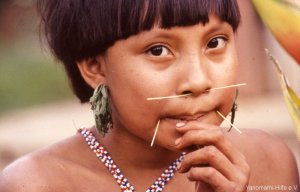Living in approximately 250 villages in the countries of Brazil and Venezuela, the Yanomami tribe is made up of 26,000 individuals that trace their existence to mystical beginnings. The Yanomami have been influenced by European slave traders, missionaries and gold miners despite the fact that many believe that they have had little contact with outsiders. With 95 percent of the tribe living in the Amazon rainforest, the Yanomami rely on foraging and horticulture and gardening and hunting, and those living near the rivers have resorted to fishing instead of hunting. The Yanomami’s main source of food comes from the village gardens, and the plantain is the largest crop. Plantains are similar to the banana but firmer and lower in sugar content. Manioc, taro, sweet potato and cane are also domestic products, and tobacco is a very important crop used for personal enjoyment.
Cotton is grown in village gardens and used to make hammocks. The most popular trade item between villages is poison arrow tips. The village homes are typically made from saplings and vines and leaves. The dwellings are not very durable and tend to be rebuilt frequently. Village size can range from 40 to 300 individuals and is strongly influenced by the positive or negative relationships between neighboring villages.
The Yanomami’s unique bowl-shaped haircut with a circle shaved bald spot in the middle distinguishes them from other tribes and individuals. The Yanomami are also distinguishable by their unique religious practices and expressive culture. Believing that the universe is constructed of four layers, the Yanomami believe that the uppermost stratum is empty and meaningless today, that the second layer is the sky and that the third layer is the layer in which the Yanomami live. The bottom layer consists of a place where the sky has fallen to the earth and the people have lost their hunting grounds. Thus, the Yanomami’s in the bottom layer resort to cannibalism, and this idea frightens the Yanomami. Nevertheless it is still a part of their belief and tradition. These individuals in the bottom layer become a spirit when they die called the hekura, and this hekura spirit has a prominent place in Yanomami shamanism. Shamanism has to do with beliefs and practices related to communicating to the spiritual world.
The Yanomami also have incorporated many myths into their society, and they use themes such as the relationship of humans to jaguars to tell their stories. The soul also plays a significant role in society and contains many different portions that play roles in life and in death. Additionally, the Yanomami believe that illness is caused by the hekura spirits and must be fought by shamanism. Shamanism can only be practiced by men, and the practice consists basically of the men calling their own good hekura spirits to them to counteract the bad hekura spirits. The process consists of a fasting for sometimes up to a year, learning the likes and dislikes of the hekura, engaging in celibacy and establishing a strong relationship with the good hekura. Additionally, shamans may only access the hekura when they are under the influence of hallucinogens. Finally, the process of caring for a body after death is pivotal to the culture of the Yanomami due to the fact that so much emphasis is placed on the soul.
The Yanomami’s have a unique social structure in that there is no ranked hierarchy. Status among men is achieved instead of ascribed, and women settle into the role of a housemaid at a young age. Marriages are arranged, and physical violence is common and accepted. A woman’s brother is her protector once he is grown and for the rest of the sister’s life, and the brother may even protect the woman from her abusive husband if the situation exists.
Politically, the Yanomami tribe forms alliances between villages, and relationships are often facilitated by trade and marriages. Feasts are a common activity in the society, and they bring together members of the community for a time of dancing, eating, rituals, chanting, trading and allow for the expression of ideas.
Many individuals disagree over whether the Yanomami culture is one that is fierce and violent. But Napoleon Chagnon, a famous anthropologist known for his study of the Yanomami, has stated that violence is an integral part of their culture. Chagnon states that wars typically begin between villages because of accusations of adultery, but other anthropologists such as Leslie Sponsel believe that the activities of the Yanomami are simply a form of sport similar to boxing or wrestling found in other parts of the world.
Current Yanomami culture is changing due to the infiltration of missionaries, roads, miners, the introduction of diseases and the destruction of the rainforests. The Yanomami culture is helping itself survive, but Chagnon has called upon the international community to help the tribe survive and maintain their culture.
To learn more about the Yanomami tribe, culture and current challenges, visit http://www.yanomami-hilfe.de/en/yanomami-2/ or http://www.survivalinternational.org/tribes/yanomami.




